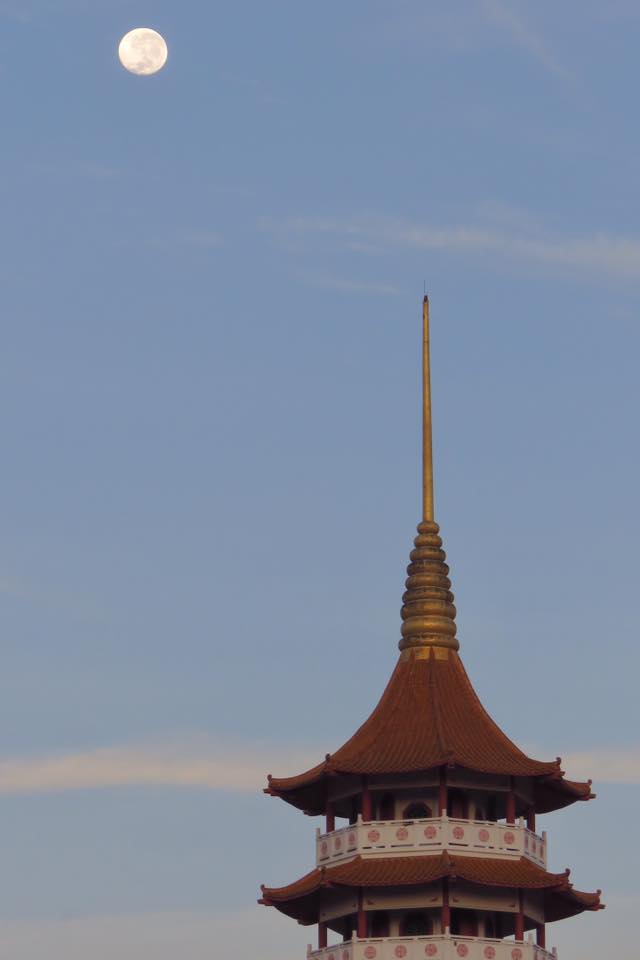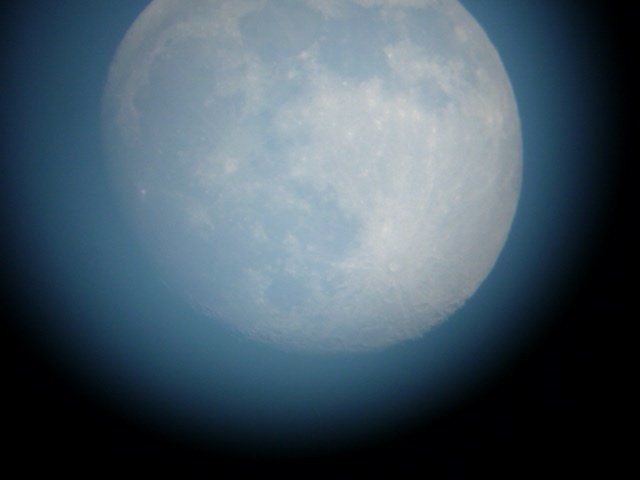
The September 2018 full moon has passed. Now the moon is in a waning gibbous phase, which means it rises in the east later and later each evening. Beginning around the morning of September 27, 2018, look west after sunrise for the daytime moon.
So you’d look east before going to bed tonight to catch the moon over the eastern horizon. Then you’d look in the west after sunrise tomorrow, or in the next few mornings, to see the daytime moon over your western horizon.
Sylvia asked:
When is the best time to see the moon in the sky during daylight hours?
The answer is that a daytime moon is up there much of the time, but, because it’s pale against the blue sky, it’s not as noticeable as the moon at night.
The most noticeable moon at night is the one that stays out all night long. That would be around the time of full moon each month, when the moon is 180o from the sun, or opposite the sun in our sky. Full moon was on September 6, 2016 at 7:03 UTC.
A full moon rises around sunset and sets around sunrise. But now the moon is in a waning gibbous phase – rising later each night – and setting in the west later each day after sunrise.
In late September, 2018 – after sunrise – look for the waning gibbous moon in the west during the morning hours. At mid-northern latitudes in North America, the moon will set roughly two hours after sunrise on September 27, and will set a solid hour later each day thereafter.
These recommended almanacs can help you find the moon’s setting time in your sky
By the way, the moon is up during the day half the time. It has to be, since it orbits around the whole Earth once a month. The crescent moon is hard to see because it’s so near the sun in the sky. At the vicinity of last quarter moon about a week from now, you might have to crane your neck, looking up, to notice it after sunrise.
Ordinarily, we don’t look up to see the waning last quarter moon and waning crescent after sunrise. That’s one reason why people so often miss the moon during the day.
Day by day, the lighted portion of the waning gibbous moon will shrink and the half-lit last quarter moon will come on October 2. Watch for the daytime moon to climb higher and higher into the western sky after sunrise all this coming week!

Jenney Disimon caught the daytime moon from Sabah, North Borneo on the morning of September 8, 2017. Thanks, Jenney!
Bottom line: Starting around the morning of September 27, 2018 look for the daytime moon in the west after sunrise!
September 2018 guide to the bright planets
The lunar calendars are almost here! They’ll help you the moon phases throughout the year.
from EarthSky https://ift.tt/1ODCsff

The September 2018 full moon has passed. Now the moon is in a waning gibbous phase, which means it rises in the east later and later each evening. Beginning around the morning of September 27, 2018, look west after sunrise for the daytime moon.
So you’d look east before going to bed tonight to catch the moon over the eastern horizon. Then you’d look in the west after sunrise tomorrow, or in the next few mornings, to see the daytime moon over your western horizon.
Sylvia asked:
When is the best time to see the moon in the sky during daylight hours?
The answer is that a daytime moon is up there much of the time, but, because it’s pale against the blue sky, it’s not as noticeable as the moon at night.
The most noticeable moon at night is the one that stays out all night long. That would be around the time of full moon each month, when the moon is 180o from the sun, or opposite the sun in our sky. Full moon was on September 6, 2016 at 7:03 UTC.
A full moon rises around sunset and sets around sunrise. But now the moon is in a waning gibbous phase – rising later each night – and setting in the west later each day after sunrise.
In late September, 2018 – after sunrise – look for the waning gibbous moon in the west during the morning hours. At mid-northern latitudes in North America, the moon will set roughly two hours after sunrise on September 27, and will set a solid hour later each day thereafter.
These recommended almanacs can help you find the moon’s setting time in your sky
By the way, the moon is up during the day half the time. It has to be, since it orbits around the whole Earth once a month. The crescent moon is hard to see because it’s so near the sun in the sky. At the vicinity of last quarter moon about a week from now, you might have to crane your neck, looking up, to notice it after sunrise.
Ordinarily, we don’t look up to see the waning last quarter moon and waning crescent after sunrise. That’s one reason why people so often miss the moon during the day.
Day by day, the lighted portion of the waning gibbous moon will shrink and the half-lit last quarter moon will come on October 2. Watch for the daytime moon to climb higher and higher into the western sky after sunrise all this coming week!

Jenney Disimon caught the daytime moon from Sabah, North Borneo on the morning of September 8, 2017. Thanks, Jenney!
Bottom line: Starting around the morning of September 27, 2018 look for the daytime moon in the west after sunrise!
September 2018 guide to the bright planets
The lunar calendars are almost here! They’ll help you the moon phases throughout the year.
from EarthSky https://ift.tt/1ODCsff


Aucun commentaire:
Enregistrer un commentaire